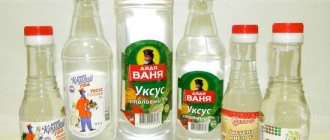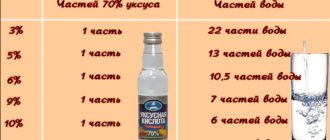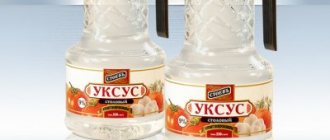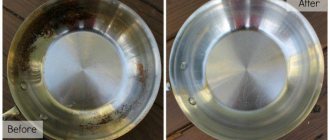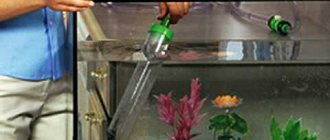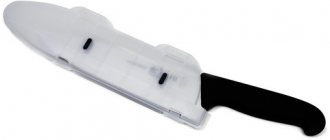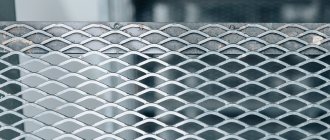How to make solutions of various concentrations at home
0
Source:
See all photos in the gallery
Concentrated vinegar 70% can be easily diluted with plain water. It’s easy and quick to make table vinegar of various strengths yourself at home, but you need to know the proportions of water and the ratio of acetic acid and essence to it. There is a simple way to make 9 percent vinegar from 70 percent vinegar. To get 9% vinegar, add two tablespoons of 70% vinegar to a faceted glass of water. Agree, with a glass on hand it is easier to dilute and understand how to dilute the 70% essence.
0
Source:
It is important to use vinegar diluted in a glass of water for its intended purpose. By following the clear instructions of the recipe, you will be able to protect yourself from the dangerous effects of undiluted acetic acid on the human body. There is a formula for diluting vinegar, but with its help you need to do the calculations yourself. For convenience, we suggest using a hint on how much water and essence you need to take:
0
Source:
By combining 1 part acid and 6 parts water, we get a 10% vinegar solution. How to dilute 70 vinegar to 9 percent? To obtain the required concentration, use a ratio of 1:7. To obtain 8 percent vinegar, mix 1 part vinegar with 8 parts water. For a 7% solution, a ratio of 1:9 is suitable. How to dilute vinegar 70 to 6? To get a 6% vinegar concentration, mix water and acid in a ratio of 11:1. Acetic essence and water in a ratio of 1:13 produces a 5% vinegar solution. Vinegar with a concentration of 4% is made from 17 parts water and 1 part acid. A 3% vinegar solution consists of 22.5 parts water and 1 part 70% vinegar essence.
Practical examples and tables of values
And now from theory to practice. 1-liter, 2-liter and 3-liter jars are usually used when preparing everyone’s favorite homemade preparations for the winter - cucumbers, spicy “Mother-in-law’s Tongue” salad and other table dishes. How much and what should be pledged?
For cucumbers and tomatoes, the ratio of components and water is approximately 1:1. This means that in a liter jar there will be about 0.5 liters of pickling and the same amount of the finished product.
Then we can easily calculate not only how to dilute acetic acid 70 to 9, but also in what quantities to take other products - such tables will help us with this.
| per jar 2 liters | per jar 3 liters | |
| cucumbers | 1 kg | 1.5 kg |
| water | 1 l | 1.5 l |
| salt | 3.5 tbsp (70 g) | 5 tablespoons (100 g) |
| sugar | 1.5 tbsp (30 g) | 2 tbsp (40 g) |
| garlic | 4 cloves | 6 cloves |
| horseradish | 2 sheets | 3 sheets |
| vinegar 9% | 6 tablespoons | 9 tablespoons |
| vinegar 70% | 2 teaspoons | 3 teaspoons |
| dry mustard | 2 dessert spoons | 3 dessert spoons |
These are the simple ratios - print these tables and save them as a reminder. Then the pickles will turn out exceptionally tasty and will be stored well.
Calculation of proportions
0
Source:
To correctly answer the question of how to dilute 70 vinegar to 9%, you should know that the presented product is divided into two types. In other words, it can be synthetic and natural. The latter seasoning is obtained as a result of long fermentation of various liquids that contain alcohols. Thus, there are apple, wine, and berry vinegars, as well as those infused with herbs and leaves of fruit bushes. As for synthetic vinegar, the main ingredient in it is acid. As a rule, it is obtained through chemical processes. They are often based on natural gas, wood distillation products, as well as some by-products obtained in industry.
0
Source:
Of course, ideally you should only eat natural vinegar. But synthetic ones can be safely used for household needs (for example, removing various stains, disinfecting, etc.). So, if you need to get highly concentrated table vinegar, then the essence should be diluted as follows: to get 30% table vinegar - 1.5 parts of ordinary drinking water; to obtain 10% table vinegar - 6 parts of ordinary drinking water; to obtain 9% table vinegar - 7 parts of ordinary drinking water; to obtain 8% table vinegar - 8 parts of ordinary drinking water; to obtain 7% table vinegar - 9 parts of ordinary drinking water. We suggest you read: How much and how to cook chicken eggs correctly
0
Source:
If you need to make low-concentrated table vinegar, then the 70% essence must be diluted in the following proportions: to obtain 6% table vinegar - 11 parts of ordinary drinking water; to obtain 5% table vinegar - 13 parts of ordinary drinking water; to obtain 4% table vinegar - 17 parts of ordinary drinking water; to obtain 3% table vinegar - 22.5 parts of ordinary drinking water.
How to dilute 9 percent vinegar to 6 percent and 3%
Diluted 9% vinegar often needs to be diluted to 6% or 3%; in other words, the existing 9% solution needs to be diluted. When diluting 9 percent vinegar, you can measure the liquid in milliliters or make calculations in grams. If you dilute two glasses of 9% vinegar with a glass of water, you get 6% table vinegar. Following this formula, it is easy to answer the question of how to dilute 9 percent vinegar to 3 percent, or how to make 6 percent vinegar from 9 percent. To dilute 70% acetic acid into solutions of other percentages, water will be required in certain proportions. You can find out how to dilute 70 percent vinegar from a convenient table.
Precautions and safety precautions
And finally, let us remind you about the necessary precautions when diluting vinegar. It is better to carry out this operation with gloves and take care of eye protection.
Avoid contact of the concentrate with the skin, especially the mucous membranes of the eyes and mouth. But if such a nuisance does occur, rinse the affected area under cool running water.
Store vinegar essence and vinegar in a dark place out of reach of children. Remember, this is an acid and can be harmful to your health if not handled correctly.
Acetic essence 70% converted to 9% vinegar: table
Before looking for information on converting 70% acetic acid into 9% vinegar, pay attention to the vinegar dilution table with ready-made calculations on how to make 9% vinegar from 70% vinegar. A table of the concentration of vinegar 70% and the ratio of one part of it to parts of water will help you independently obtain a correctly diluted solution: Example: 3% vinegar is obtained from 1 part vinegar and 22 parts water; 4% – 1:17; 5% – 1:13; 6% – 1:11; 7% – 1:9; 8% – 1:8; 9% – 1:7; 10% – 1:6; 30% – 1:1.5; 40% – combine with 0.8 part of water.
Main varieties
There are two main types of vinegar: synthetic or industrial (also called table vinegar) and natural.
Natural is obtained as a result of the natural fermentation of alcohol-containing products when exposed to acetic acid bacteria, and can be very diverse:
- wine;
- balsamic;
- fruit and berry;
- apple;
- alcohol.
The natural product contains, in addition to acetic acid, other fruit acids, esters, vitamins and minerals. However, its acidity, as a rule, does not exceed 6%. This composition makes the spice not only aromatic, but also very healthy.
Synthetic, in turn, is a product artificially created in industrial conditions. It is obtained by diluting the synthesized concentrated acetic acid. The latter is sometimes called ice (at a concentration close to 100%).
How to make nine percent vinegar
Table vinegar of this concentration is used for canning food. How to dilute vinegar essence to obtain a solution with a concentration of 9%? It is necessary to dilute the essence with 70% water in the ratio: 1 part concentrate and 7 parts water. That is, for 0.5 liters of water you need to add 75 ml of essence (one and a half shot glasses). A solution of table vinegar is recommended to be used as a rubdown for diseases accompanied by an increase in body temperature. How to dilute vinegar essence at temperature? Pour one liter of water into an enamel bowl and add 2 tbsp. l. 9% table or apple cider vinegar. Six percent table vinegar is added to meat marinades. How to dilute vinegar essence: 10.5 parts water to 1 part concentrate. To obtain 0.5 liters of solution, take 45 ml of essence (three tablespoons). Table vinegar with a concentration of 3% is used to season ready-made dishes: salads, dumplings, pickled mushrooms, onions, sauces, etc. How to properly dilute vinegar essence and get a three percent solution: take 22 parts of water for one part of the essence. To prepare 0.5 liters of table vinegar you need 20 ml of vinegar essence 70%. Dilute the essence in a glass or enamel container. First, the required amount of clean drinking water is measured into it. The water should be cool. Then add the calculated amount of vinegar essence. Avoid contact of the concentrate with the skin and especially with the mucous membranes of the eyes and mouth. But if such a nuisance does occur, rinse the affected area under cool running water. We suggest you read where acetic acid is used
Pollock fish cutlets without bread - Not only tasty, but also healthy!
Continuing the theme of healthier eating, I want to offer you a wonderful recipe for fish cutlets - minced pollock cutlets. Pollock is an excellent choice for fish cutlets: it is not an expensive type of fish, has few bones, no need to peel scales, and as for the beneficial properties (content of vitamins A, B1, B2, B9, minerals and trace elements) - it is in no way inferior expensive fish.
The only complaint about pollock is that the minced meat can turn out a little dry. For those who do not have enough fat content, you can roll an additional piece of lard into the minced meat or add a couple of tablespoons of olive oil to the minced meat. For fish cutlets, it is generally typical to take low-fat varieties of white fish, but at the same time increase the fat content with separate additives.
By the way, another original and “tasty” way to add fat content to dry fish (and not only fish) mince. Directly in the frying pan, put a piece of frozen butter into the already prepared cutlets, press it in so that it is inside the minced meat. During cooking, the butter will melt and give the dish a great creamy taste!
But, if we talk about the benefits of such a product as fish cutlets (and this is a dietary dish by all standards!), then you don’t need to add anything, no additional fats are required. This recipe also calls for a small amount of oil in the pan and the absence of bread and flour in the cutlets.
If you don’t have special cookware with a non-stick coating on which you can fry almost without oil, you can cook these cutlets in the oven, or steam them, whichever you prefer.
I still like the cutlets to look more browned; a small, slightly toasted crust won’t hurt, the main thing is to cook over very moderate heat and with a small amount of oil.
Compound:
- minced pollock - 1.3 kg.
- onions – 3 pcs.
medium size
- potatoes – 3 pcs.
- garlic – 3 cloves
- egg – 3 pcs.
- salt, pepper, spices - to taste
Step-by-step recipe for making pollock cutlets:
5 Fry in a small amount of oil, without a lid, over low heat until golden brown, turning during cooking. Fish cutlets cook very quickly. But you can further steam them after frying under the lid, adding a little water.
Let me remind you that in this recipe, for the sake of health benefits and increasing the “dietary value” of our dish, we excluded bread completely. But according to tradition, in the classic recipe for fish cutlets, bread must be added, and in fish cutlets, the bread is usually soaked in milk, and not in water. Still, fish cutlets require more gentle handling
In what cases is it necessary to dilute vinegar?
0
Source:
At home, acetic acid is often used in cooking and as a traditional medicine. In diluted form, it is used externally to treat joints, heel spurs, and reduce elevated body temperature with vinegar compresses. For cosmetic purposes, a low concentration solution is used to rinse hair. The vinegar solution is used to wipe the skin of the face and body; people drink apple cider vinegar to lose weight. Diluted vinegar is included in mixtures against pests of cabbage, currants and indoor plants. The vinegar solution has an effective effect on tomatoes; gardeners use it to prevent late blight, against aphids on cucumbers, and to treat bell pepper ovaries against pests. If you dilute vinegar correctly, its solution is suitable for any purpose. Vinegar inherently has a wide range of applications; it is used for various purposes. The sour-tasting solution serves as an indispensable seasoning for dumplings. Diluted and undiluted 70% vinegar is added as a preservative for preparing homemade squash caviar for the winter, when marinating champignons in jars, wild mushrooms for future use and vegetables. As the main ingredient, vinegar can be found in almost all recipes for marinades of cabbage, meat kebabs with onions, and preparing sushi rice.
General information about acetic acid
In chemistry, this substance is called ethanoic acid. Its chemical formula is CH3COOH. Since ancient times, the mass has been obtained through the fermentation of grape wine or other products. During the Renaissance, metal acetates began to be used for this purpose.
It is worth noting that the characteristics of the product vary depending on the dissolution. This means that solutions of different concentrations differ in properties. Therefore, chemists have long believed that a product made with metal acetates is a different substance than a composition made from organic matter. Only in the sixteenth century was it possible to establish that, regardless of the method of preparation, the composition is the same acid.
In the nineteenth century, the substance was obtained through the synthesis of inorganic elements. In this case, the starting material was carbon disulfide. Under normal conditions, acetic acid is an aqueous solution, the concentration of which reaches 80%. There is also anhydrous or glacial acid. Its concentration level reaches 99-100%. In addition, acetic anhydride is produced, which is used in pharmaceuticals.
